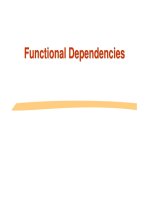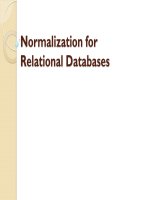Distributed Database Management Systems: Lecture 24
Bạn đang xem bản rút gọn của tài liệu. Xem và tải ngay bản đầy đủ của tài liệu tại đây (238.11 KB, 35 trang )
Distributed Database
Management Systems
Lecture 24
Distributed Database
Management Systems
Virtual University of
Pakistan
Fragmentation
• We know there are different
types, we start with the
simplest one and that is the
PHF
• Supposedly, you have already
gone through the design
phase and have got the
predicates to be used as basis
for PHF, just as a reminder
• From the user queries, we first
collect the simple predicates
and then we form a complete
and minimal set of minterm
predicates, a minterm
predicate is ….., you know that
otherwise refer back to lecture
16, 17
• Lets say we go back to our
Bank example, and lets say
we have decided to place
our servers at QTA and
PESH so we have two
servers where we are going
to place our PHFs
• As before we register our servers and
now at our Enterprise Manager we
can see two instances of SS
• At each of the three sites we define
one database named BANK and also
one relation, normal base table,
however, for the fragmentations to be
disjoint (a correctness requirement)
we place a check on each table at
three sites, how….
• We name our fragments/local
tables as custQTA, custPESH
• Each table is defined as
create table custPESH(custId char(6),
custName varchar(25), custBal
number(10,2), custArea char(5))
• In the same way we create 2
tables one at each of our two
sites, meant for containing the
local users
• Users that fall in that area and the
value of the attribute custArea is
going to be the area where a
customer’s branch is, so its
domain is {pesh, qta)
• To ensure the disjointness and
also to ensure the proper
functioning of the system, we
apply a check on the tables
• The check is
• Peshawar customers are
allocated from the range
C00001 to C50000, likewise
• QTA is C50001 to C99999
• So we apply the check on
both tables/fragments
accordingly, although they
can be applied while
creating the table, we can
also apply them later, like
• Alter table custPesh add
constraint chkPsh check
((custId between ‘C00001’ and
‘C50000’) and (custArea =
‘Pesh’))
• Alter table custQTA add
constraint chkQta check
((custId between ‘C50001’ and
‘C99999’) and (custArea =
‘Qta’))
• Tables have been created on
local sites and are ready to be
populated, start running
applications on them, and data
enters the table, and the
checks ensure the entry of
proper data in each table.
Now, the tables are being
populated
Example Data in PESH
C0001
C0002
C0003
C0005
Gul Khan
Ali Khan
Gul Bibi
Jan Khan
4593.33
45322.1
6544.54
9849.44
Pesh
Pesh
Pesh
Pesh
Example Data at QTA
C50001
C50002
C50003
C50004
Suhail Gujjar
Kauser Perveen
Arif Jat
Amjad Gul
3593.33
3322.1
16544.5
8889.44
Qta
Qta
Qta
Qta
• Next thing is to create a global view
for the global access/queries, for this
we have to link the servers with each
other, this is required
• You have already registered both the
servers, now to link them
• You can link them using Enterprise
Manager or alternatively through
SQL, we do here using SQL
• Connect Pesh using Query
Analyzer
• Then execute the stored
procedure sp_addlinkedserver
• The syntax is
• sp_addlinkedserver
@server = ‘QTA',
@srvproduct = '',
@provider = 'sqloledb',
@datasrc = ‘mysystem\QTA‘
• You will get two messages, if
successful, like ‘1 row added’
and ‘1 row added’
• You have introduced
QTA as a linked server
with PESH.
• We have to perform this
operation on the other
server, that is, we have
to add linked server
PESH at QTA
• Setup is there, next thing is to
create a partitioned view
• In SQL Server, a partitioned
view joins horizontally
partitioned data across
multiple servers
• The statement to create the
partitioned view is
• Create view custG as
select * from custPesh
Union All
select * from QTA.bank.dbo.custQTA
• Likewise, we have to apply same
command at QTA
• Create view custG as
select * from custQta
Union All
select * from PESH.bank.dbo.custPesh
• Once it is defined, now when
you access data from custG, it
gives you data from all four
site.
• It is also transparent
• Now lets say if you are
connected with Pesh, and you
give the command
Select * from custPesh
You get the output
• Same is the case with the
users of the QTA server, they
pose the query
• Select * from custQTA
• Like a local user









